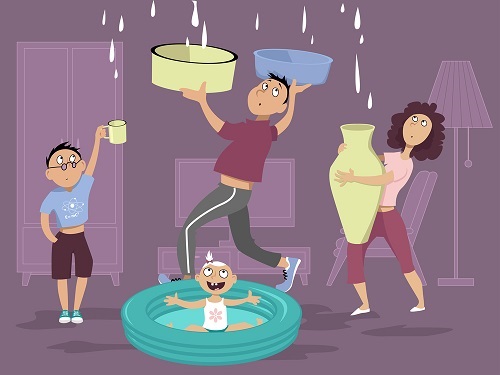
Do you have a ceiling leak after the recent rainstorms in your area? You may be looking for ways to regularly keep your home clean and dry. It is vital that you understand how to stop a roof leak. Consider factors both inside and outside that allow water to enter the home.
Our roofing knowledge will allow you to restore your roof and create a more comfortable, dryer environment in your home.
Here are some tips on how to stop roof leaks in the rain.
1. Find the source
You must know what causes water to enter your home to stop a ceiling from leaking. You will save money and time on the tools required to make roof repairs in Myrtle Beach.
Check your roof first to see if there are any problems. Clogged gutters, pests and problems with heating and cooling systems, plumbing and the HVAC system are all possible sources of leaks.
If you notice any damage to the tiles or drywall on your ceiling and roof, check them. Leaks may occur in areas that are not aligned.
2. Clear the Area
You can begin repairing the area once you know the source of the leak. You can prevent roof damage by clearing the area where water could enter.
You can place pails under the leak to collect any extra water. You can use suction hoses to fix leaks coming from above.
Do not forget to move the furniture and appliances away from the source of the leak. Cover the furniture with plastic if it is heavy or difficult to move.
3. Use Roofing Tar
You must assess the exterior of your house before you can fix a leaky roof from the interior. Keep the roof tiles in good condition.
Roof tar patches are the best option for tiles that can be removed. Roof tar will seal any leaks in the inner ceiling if you remove the tiles. It will perform better if a shingle, plywood or other material supports it. The shingle or the plywood can be pushed against the area that leaks, and the roofing tar is applied to keep it dry.
4. Use PE Plastic
Certain covering materials are best for leaks but are harder to locate. Polyethene (PE), for example, can reduce the space that is affected by leaks. It can also catch any water that tries to enter.
 You can use a ruler and a calculator to determine how much plastic is needed to cover the leakage area. We recommend giving your plastic an extra three to four feet to minimise future leaks.
You can use a ruler and a calculator to determine how much plastic is needed to cover the leakage area. We recommend giving your plastic an extra three to four feet to minimise future leaks.
Use staples and nails to secure the plastic. Keep your PE as thick as you can to shield your room from as much moisture as possible.
5. Install New Shingles
Your roof’s ability to stop leaks is also affected by the condition of your shingles. Water can easily enter your home through damaged shingles.
Wear safety gloves when removing old shingles to prevent cuts. Wear rubber boots before you climb the ladder to reach the leaky area.
Replace the broken and old shingles using roofing tar and nails. This is a temporary solution until you can find something more durable to protect your roof from rain.
6. Tarpaulins are a great way to protect your home.
You may expect a storm tomorrow and need to fix your roof leak quickly. Installing a tarpaulin can be used to cover areas where you suspect exterior leaks.
You may need to use a larger tarp if you have multiple leaks or if you have a large roof. Multiple tarps are useful for roofs that are too large to handle multiple leaks or leaks at different locations.
We recommend anchoring your tarp using heavy concrete blocks for storms that are likely to bring heavy rain and high winds. We also suggest extending the tarp over the ridge. If you’re dealing with a milder storm, nails can be helpful.
7. Seal Joints
You may be more likely to leak if it comes from the joints of your roof. Rainwater can enter your home via gaps and through aluminum and chalk flashing at the junctions of surfaces.
You can seal these areas with cement or roof sealant. Ensure the area is clean and dry before you apply the sealant.
Use new flashing for larger roof cracks. Save sealant to fix more minor leaks. Knowing what tools to use can reduce future problems and save money on a roof replacement in the future.
Roof Leaks: How to Stop Them
Understanding the cause of a roof leak will help you prevent it from happening again. Some covers are better suited to short-term protection, while others will help keep your roof dry on a long-term basis. You should also consider the type of storms that you will be facing. These tips will help you to enjoy a dry room before, during and after a rainstorm.
Call MB Roofing Pros at 843-492-0778 if you need help with your roof.
Like our Facebook page for more great info about roofing services.
MB Roofing Pros
Myrtle Beach, SC 29577
843-492-0778
http://roofing-myrtlebeach.com/

No comments:
Post a Comment